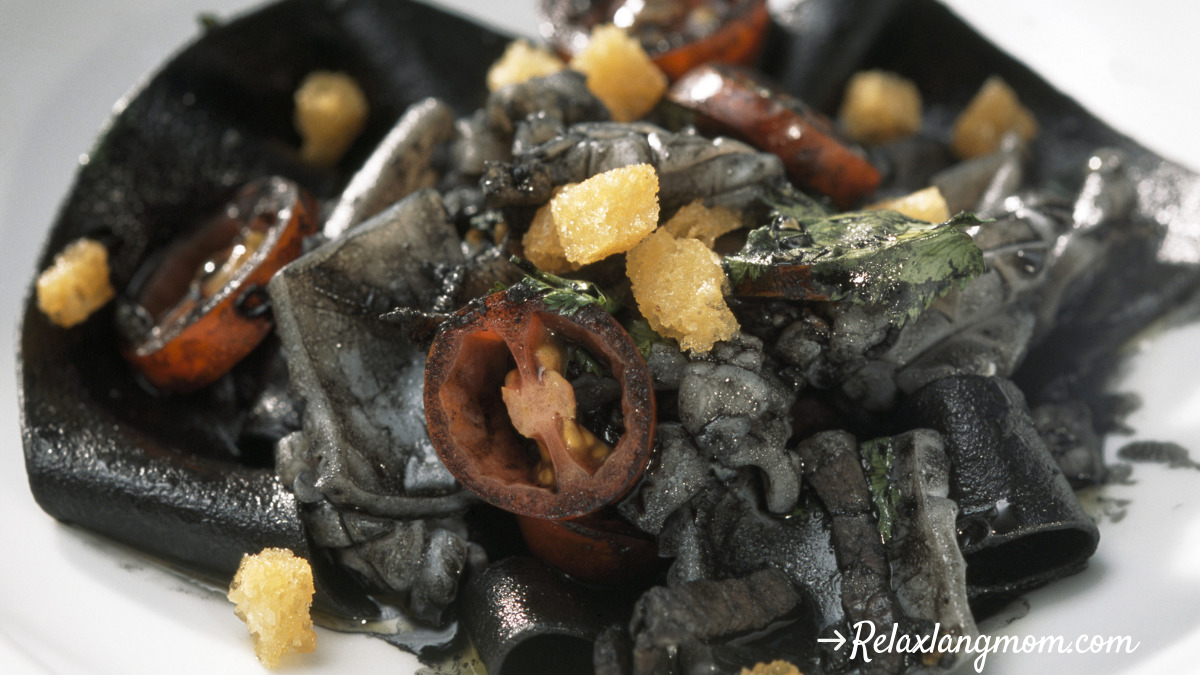The “Calamares en Su Tinta”, or Squid in its Own Ink is a very simple but flavorful dish that is elegant in taste. It is Spanish in origin and made with pieces of calamari (tentacles included), the dish is cooked inside its own ink, which gives it a rich, savory taste and a distinct black color.
The dish is said to have originated from the coastal regions of Spain, where fishermen would cook the calamari they caught in its own ink to preserve its freshness. Over time, the dish evolved into a popular and highly-regarded delicacy, enjoyed for its unique flavor and rich, savory taste.
Ingredients and Preparation of Calamares en Su Tinta
The main ingredients for Calamares en su tinta are calamari and its own ink, along with a few other simple ingredients such as olive oil, garlic, and herbs. The calamari is cleaned and cut into pieces, and then cooked in its own ink along with the other ingredients. The result is a flavorful and aromatic dish that is both rich and satisfying and it almost tastes likes our Adobo sa Kamatis. Growing up in the islands, with abundant supplies of seafood, this squid recipe is very familiar yet different at the same time.
I’m guessing its the olive oil and the wine which makes a lot of difference. It makes it a lot more sosyal and admittedly more pricey than a regular Adobong pusit but the taste is just so good!
In Spain, Calamares en su tinta is widely available in supermarkets and specialty food stores, where it is often sold in cans and ready to enjoy. However, for those looking for a more authentic experience, do make the dish at home using fresh squid and squid ink. Whether you purchase it ready-made or make it at home, Calamares en su tinta is a dish that is sure to impress and delight your taste buds.
Cleaning the Squid
Cleaning squid properly is an important step in ensuring that your Calamares en su tinta or any other squid dish turns out delicious. Squid can be a little intimidating to work with, but with the right techniques, it is a relatively easy and straightforward process. Here are the steps for properly cleaning squid:
- Remove the Head: Start by removing the head of the squid. Grasp the head firmly and twist it to separate it from the body. Discard the head and the innards that are located inside.
- Remove the Quill: The next step is to remove the quill, which is a transparent, gelatinous structure inside the body of the squid. Reach into the body of the squid and gently pull out the quill. Discard it.
- Clean the Body: Once the quill has been removed, rinse the inside of the body of the squid with cold water. Gently scrub the inside of the body with your fingers to remove any dirt or debris. Rinse the body again and set it aside.
- Remove the Skin: To remove the skin from the squid, start at the top of the body and gently peel it off, working your way down to the tentacles. The skin should come off easily, but if it is difficult to remove, use a sharp knife to help. Discard the skin.
- Clean the Tentacles: Clean the tentacles by gently rinsing them with cold water. Use your fingers to remove any dirt or debris from the tentacles. Rinse the tentacles again and set them aside.
- Prepare for Cooking: Once the squid has been cleaned, it is ready for cooking. Cut the body into rings or into pieces as desired. To use the ink for Calamares en su tinta, carefully cut a small opening in the ink sac located near the head and squeeze the ink into a separate bowl.
With these simple steps, your squid will be properly cleaned and ready for your next culinary creation. Whether you are making Calamares en su tinta or any other squid dish, proper cleaning is a key part of the preparation process. So, don’t be intimidated by cleaning squid and give it a try!
Calamares en Su Tinta (Squid in their own ink)
Ingredients
- 500 g squid
- 2 tbsp salt
- 1/4 cup sugar
- squid ink
- 1 ripe tomato
- 2 large onions
- 1 clove garlic
- 1 cup of white wine
- 1 piece of stale bread
- Olive oil
- Salt
Instructions
- Clean the squid.
- Carefully remove the ink sac.
- Chop into bite-size pieces if using the big calamari.
- Toss the squid with the salt and sugar, and let sit for 15 minutes before rinsing again.
- Make the sauce.
- Stir-fry the onions, sliced garlic, and finely chopped tomatoes in olive oil.
- Then add the diced stale bread and leave for a few minutes until soft.
- Add the squid ink mixed with the white wine. Cook on low for half an hour.
- When the sauce is ready, strain through a purée sieve to obtain a creamy liquid. Add the squid and cook for 20 minutes.
https://tourism.euskadi.eus/en/dishes-tapas/squid-in-its-own-ink-sauce/aa30-12375/en/


